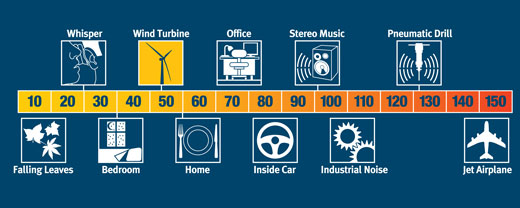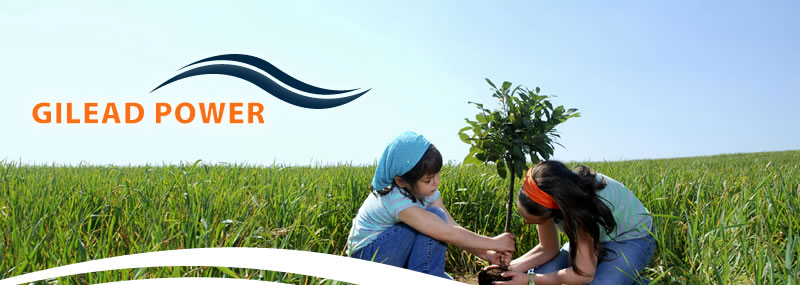| Wind Energy Facts
Find out why wind power is a natural choice. As with any source of energy, wind power has demonstrated its global benefits, and resolved any potential local drawbacks. Compare wind to conventional forms of pollution producing fuels and make informed decisions, by knowing firsthand the facts.
Myth: Wind farms are noisy.
Fact: The evolution of wind farm technology over the past decade has rendered mechanical noise from turbines almost undetectable with the main sound being the aerodynamic swoosh of the blades passing the tower. There are strict guidelines on wind turbines and noise emissions to ensure the protection of residential amenity. The best advice for any doubter is to go and hear for yourself! Click here to download the decibels chart in PDF.

Myth: Wind farms won't help climate change.
Fact: Wind power is a clean, renewable source of energy which produces no greenhouse gas emissions or waste products. Power stations are the largest contributor to carbon emissions. We need to switch to forms of energy that do not produce CO2. Just one modern wind turbine will save over 4,000 tonnes of CO2 emissions annually.
Myth: Wind farms kill birds.
Fact: Today, the wind energy industry has put procedures in place to enhance our understanding of birds and how they interrelate with wind turbines. The modern wind farm undergoes a series of environmental assessments before being approved. In this process, the proposed site will be monitored and bird populations evaluated. What kinds of birds are on site? What are their habits, flight patterns? Do they nest in the area or simply fly through? Questions like these are answered in an effort to better understand on-site bird populations and to mitigate their potential interactions with wind turbines. Once built, further monitoring takes place to better understand the ongoing relationship between birds and the wind farm.
A real concern for birds is noted in the 2004 study in Nature that estimated that up to a quarter of all bird species could become extinct by 2054 due to global climate change, for which wind energy is one of the solutions.
Myth: Wind farms are dangerous to humans.
Fact: Wind energy is a benign technology with no associated emissions, harmful pollutants or waste products. In over 25 years and with more than 68,000 turbines installed around the world, no member of the public has ever been harmed by wind turbines. In response to recent unscientific accusations that wind turbines emit infrasound and cause associated health problems, Dr Geoff Leventhall, Consultant in Noise Vibration and Acoustics and author of the Defra Report on Low Frequency Noise and its Effects 16, says: "I can state quite categorically that there is no significant infrasound from current designs of wind turbines. To say that there is an infrasound problem is one of the hares which objectors to wind farms like to run. There will not be any effects from infrasound from the turbines."
Myth: Building a wind farm takes more energy than it ever makes.
Fact: A wind turbine produces enough clean electricity in 3-5 months to offset all of the greenhouse gas emissions emitted in its manufacture - and it will produce clean electricity for another 20-25 years. This compares favourably with coal or nuclear power stations, which take about six months. A modern wind turbine is designed to operate for more than 20 years and at the end of its working life, the area can be restored at low financial and environmental costs.
Myth: Wind farms are inefficient, they are only operational 30% of the time.
Fact: A modern wind turbine produces electricity 70-85% of the time, but it generates different outputs dependent on wind speed. Over the course of a year, it will generate about 30% of the theoretical maximum output. This is known as its load factor. The load factor of conventional power stations is on average 50%. A modern wind turbine will generate enough to meet the electricity demands of more than a thousand homes over the course of a year.
Myth: Wind energy needs back-up to work.
Fact: All forms of power generation require back up and no energy technology can be relied upon 100%. Variations in the output from wind farms are barely noticeable over and above the normal fluctuation in supply and demand, seen when the nation's workforce goes home, or if lightning brings down a high-voltage transmission line. Therefore, at present there is no need for additional back-up because of wind energy.
Myth: Wind power is expensive.
Fact: The cost of generating electricity from wind has fallen dramatically over the past few years. Between 1990 and 2002, world wind energy capacity doubled every three years and with every doubling prices fell by 15%. Wind energy is competitive with new coal and new nuclear capacity, even before any environmental costs of fossil fuel and nuclear generation are taken into account. As gas prices increase and wind power costs fall - both of which are very likely - wind becomes even more competitive.
Wind is a free and widely available fuel source, therefore once the wind farm is in place, there is no fuel or waste related costs.
Myth: We should invest in other renewable energy technologies and energy efficiency instead of wind power.
Fact: Wind energy's role in combating climate change is not a matter of either-or. We will need a mix of new and existing renewable energy technologies and energy efficiency measures, and as quickly as possible. Wind energy is the most cost effective renewable energy source available to generate clean electricity and help combat climate change right now. Furthermore, developing a strong wind industry will facilitate other renewable technologies which have not reached commercialisation yet, accumulating valuable experience in dealing with issues such as grid connection, supply chain and finance.
Myth: Wind farms should all be put out at sea.
Fact: At present, onshore wind is more economical than development offshore. However, more offshore wind farms are now under construction in other countries. Offshore wind farms take longer to develop as the sea is a more hostile environment. To expect offshore to be the only form of wind generation allowed would therefore be to condemn us to missing our renewable energy targets and commitment to tackle climate change.
Myth: Wind farms are ugly and unpopular.
Fact: Beauty is in the eye of the beholder, and whether you think a wind turbine is attractive or not will always be your personal opinion. However, studies regularly show that most people find turbines an interesting feature of the landscape. On average 80% of the public support wind energy, less than 10% are against it, the remainder are undecided. Surveys conducted near existing wind farms have consistently found that most people are in favour of wind energy.
Content source is the copyright property of CANWEA and has been reproduced with their permission.
Some of this information excerpts from www.embracewind.com |

